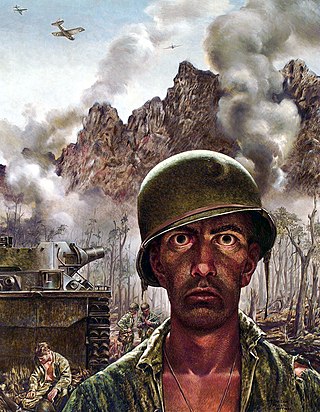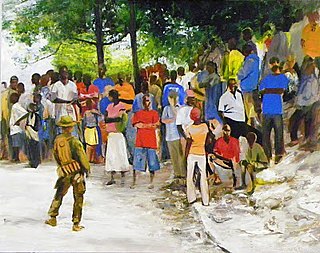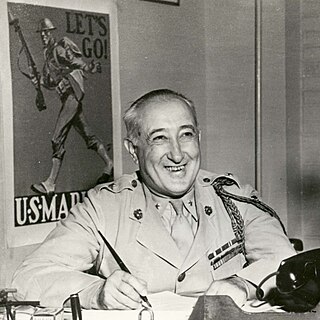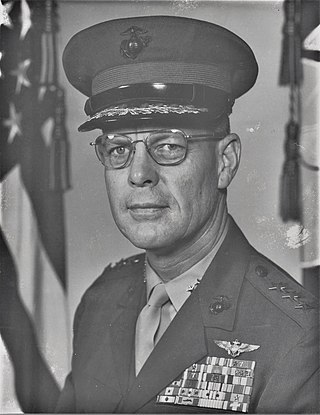
Kristopher J. Battles is an American artist, known as the last remaining USMC combat artist in 2010. [1]

Kristopher J. Battles is an American artist, known as the last remaining USMC combat artist in 2010. [1]
Battles joined the Corps in 1986. He served as a computer operator, combat correspondent and chaplain's assistant. He had to reenlist for active duty as a combat artist. [2]
... the Marine Corps' philosophy, and I think all good art, is that if you go and you see and you paint what you feel and you have seen and experienced, it's much more authentic. And the philosophy of the Marine Corps and the combat art program is that it's much stronger expression if you go to a situation and you see it and you experience it. — Sgt. Kristopher Battles [3]
The United States Marine Corps supported more than 70 war artists in World War II; and the number of combat artists has declined since the end of the Vietnam War. In July 2010, the Corps supports only one last combat artist. Unless something happens, Sergeant Battles will become notable as the last of his kind. [1]
Since World War I, a long line of American servicemen-artists have produced artwork based on their experiences in combat. [4] The USMC artists have documented the life of Marines in the field. Like his predecessors, Sgt. Battles' artwork develops during a process of "balancing a tactical eye as a Marine" with the "artist's visual eye" and also noticing the way the light is bouncing off the body armor. [1] Battles' deployment to Iraq gave him a sharper eye for what can be portrayed in a combat zone. [2]

"Go to war, do art" is the motto of a Marine combat artist. The mission is to capture images of war on canvases and sketchpads. [3]

The Battle Dress Uniform (BDU) is a camouflaged combat uniform that was used by the United States Armed Forces as their standard combat uniform from the early 1980s to the mid-2000s. Since then, it has been replaced or supplanted in every branch of the U.S. Armed Forces.

The thousand-yard stare is a phrase often used to describe the blank, unfocused gaze of combatants who have become emotionally detached from the traumatizing things around them. It is sometimes used more generally to describe the look of dissociation among victims of other types of trauma.

The 5th Marine Regiment is an infantry regiment of the United States Marine Corps based at Marine Corps Base Camp Pendleton, California. It is the most highly decorated regiment in the Marine Corps and falls under the command of the 1st Marine Division and the I Marine Expeditionary Force.

The 3rd Marine Littoral Regiment is a regiment of the United States Marine Corps that is optimized for littoral maneuver in the Indo-Pacific Theater. Based at Marine Corps Base Hawaii, the regiment falls under the command of the 3rd Marine Division and the III Marine Expeditionary Force. It was known as the 3rd Marine Regiment from 1914 to 2022, when it was renamed as part of the Commandant of the Marine Corps' Force Design 2030 initiative. The 3rd MLR has participated in the 2022 and 2023 Balikatan exercises in Northern Luzon, Philippines.

1st Battalion, 3rd Marines (1/3) is an infantry battalion in the United States Marine Corps based out of Marine Corps Base Hawaii. Nicknamed the "Lava Dogs", the battalion consists of approximately 800 Marines and sailors and falls under the command of the 3rd Marine Regiment of the 3rd Marine Division.

2nd Battalion, 6th Marines (2/6) is an infantry battalion in the United States Marine Corps based out of Camp Lejeune, North Carolina. Also known as "The Ready Battalion" or "2/6 Spartans", it consists of approximately 800 Marines and Sailors and falls under the command of the 6th Marine Regiment and the 2nd Marine Division.

Sergeant James Edmund Johnson was a posthumous recipient of the United States' highest decoration — the Medal of Honor — for his heroic lone fight on December 2, 1950, to cover the withdrawal of his platoon during the bitter Chosin Reservoir campaign in Korea. When last seen by his comrades Johnson was wounded, but still engaging the enemy in close grenade and hand-to-hand combat. The enemy were wearing the uniforms of friendly troops at the time. He was listed as missing in action until December 2, 1953, when his status was officially changed to killed in action.

2nd Battalion, 9th Marines (2/9) was an infantry battalion of the United States Marine Corps. Formed during World War I, the unit played an instrumental role in the defeat of the Japanese forces in the Battles of Guam and Iwo Jima during World War II. The battalion distinguished itself in the defense of Khe Sanh during the Vietnam War, and later participated in an ill-fated invasion of Koh Tang Island in Southeast Asia, with the intention of rescuing the crew of SS Mayaguez. During Operation Desert Storm, the battalion served as the lead battalion for the III Marine Expeditionary Force.
Louis R. Lowery was a United States Marine Corps captain. He was the only Marine Corps combat photographer to cover six major campaigns during World War II. He is best known for taking the first photographs of the first American flag that was raised on top of Mount Suribachi during the Battle of Iwo Jima on the morning of February 23, 1945.
Harold George Schrier was a United States Marine Corps lieutenant colonel who served in World War II and the Korean War. In World War II, he was awarded the Navy Cross for leading the patrol that captured the top of Mount Suribachi, where he helped raise the first U.S. flag on Iwo Jima on February 23, 1945. In the Korean War, he was wounded in North Korea during the Battle of Chosin Reservoir while commanding a rifle company.
Hispanics in the United States Marine Corps, such as Private France Silva who during the Boxer Rebellion became the first Marine of the thirteen Marines of Latin American descent to be awarded the Medal of Honor, and Private First Class Guy Gabaldon who is credited with capturing over 1,000 enemy soldiers and civilians during World War II, have distinguished themselves in combat. Hispanics have participated as members of the United States Marine Corps in the Boxer Rebellion, World War I, the American intervention in Latin America also known as the Banana Wars, World War II, the Korean War, the Vietnam War, the Gulf War and most recently in the military campaigns of Afghanistan and Iraq.

The United States Marine Corps (USMC), also referred to as the United States Marines, is the maritime land force service branch of the United States Armed Forces responsible for conducting expeditionary and amphibious operations through combined arms, implementing its own infantry, artillery, aerial, and special operations forces. The U.S. Marine Corps is one of the eight uniformed services of the United States.

Alpha Lyons Bowser was a United States Marine Corps lieutenant general. He was a combat veteran of World War II and the Korean War – decorated for his actions during the Battle of Iwo Jima and in the Battle of Chosin Reservoir.
The United States Army Art Program or U.S. Army Combat Art Program is a U.S. Army program to create artwork documenting its involvements in war and peacetime engagements. The art collection associated with the program is held by the U.S. Army Center of Military History. The United States Army Centre of Military History built the National Museum of the United States Army at Fort Belvoir that is now completed and will open when conditions allow.

American official war artists have been part of the American military since 1917. Artists are unlike the objective camera lens which records only a single instant and no more. The war artist captures instantaneous action and conflates earlier moments of the same scene within one compelling image.
"We're not here to do poster art or recruiting posters... What we are sent to do is to go to the experience, see what is really there and document it—as artists."

Robert Livingston Denig Sr. was a decorated United States Marine Corps brigadier general who served in World War I, and served as its first director of public information during World War II. He is credited with "fathering" the idea of combat correspondents in the United States Armed Forces during World War II.
Michael D. Fay is a former United States Marine Corps combat artist. Before his retirement from the Corps, he was a war artist serving in Iraq. He was deployed as an artist-correspondent embedded with US troops in Afghanistan. He resides in Fredericksburg, Virginia.

William James White was a decorated lieutenant general in the United States Marine Corps. He was awarded the Silver Star, the United States military's third-highest personal decoration for valor in combat, for his actions in the Korean War. He later served as deputy chief of staff for aviation at Headquarters Marine Corps.

The School of Advanced Warfighting (SAW) in the United States Marine Corps is an Advanced Intermediate Level School (A-ILS) that produces officers qualified to fill high-impact service and joint planning billets. The curriculum features numerous case studies, multiple planning exercises, extensive staff rides, and a consideration of future war. Graduates earn the secondary Military Occupational Specialty (MOS) 0505 Marine Air Ground Task Force (MAGTF) planner and a Masters Degree in Operational Studies. SAW was designed to develop field grade officers for the Marine Corps most difficult operational and planning challenges.